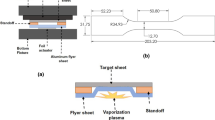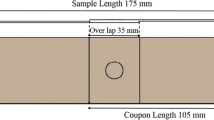Abstract
Vaporizing foil actuator (VFA) spot welding, a type of spot impact welding, was used to weld a titanium alloy (Ti-1.2ASN) to a stainless steel (436 SS). The interfacial microstructures and fracture surfaces were characterized using scanning electron microscopy (SEM). Lap shear tests that strained the samples to failure with digital imaging correlation (DIC) were conducted to study the mechanical performance of these welds. A mesh-insensitive structural stress method was used to understand the stress distribution and model the failure modes of VFA welds in ABAQUS. Despite experimental scatter in this developing joining method, most samples failed through the base metal, but multiple failure modes coexisted, including interface failure. These failure modes were used to classify the results. The failure process can be best understood through the lens of the spatial variation that is natural in this type of weld. The center is naturally unwelded, and there is an annulus of high strength material surrounding this unwelded zone that has a wavy morphology. The mesh-insensitive structural stress method could naturally provide a link between the joint structure and the mechanical properties of the spot impact welds. This could show that despite varied failure modes and nugget strength, strength itself is not usually affected adversely by the size of the central unbonded zone.

















Similar content being viewed by others
Data availability
The raw data used to reproduce the results cannot be completely shared due to an ongoing research along with this project. Part of the unpublished data will be attached as supplementary materials.
References
Gangwar K, Ramulu M (2018) Friction stir welding of titanium alloys: a review. Mater Des 141:230–255
Dey HC, Ashfaq M, Bhaduria AK, Prasad Rao K (2009) Joining of titanium to 304 L stainless steel by friction welding. J Mater Process Technol 209:5862–5870
Tomashchuk I, Grevey D, Sallamand P (2015) Dissimilar laser welding of AISI316Lstainless steel to Ti6–Al4–6V alloy via pure vanadium interlayer. Mater Sci Eng A 622:37–45
Tomashchuk I, Sallamand P, Belyavina N, Pilloz M (2013) Evolution of microstructures and mechanical properties during dissimilar electron beam welding of titanium alloy to stainless steel via copper interlayer. Mater Sci Eng A 585:114–122
Muralimohan CH, Muthupandi V, Sivaprasad K (2014) Properties of friction welding titanium-stainless steel joints with a nickle interlayer. Procedia Mater Sci 5:1120–1129
Fazel-Najafabadi M, Kashani-Bozorg SF, Zarei-Hanzaki A (2010) Joining of CP-Ti to 304 stainless steel using friction stir welding technique. Mater Des 31:4800–4807
Kundu S, Chatterjee S (2006) Interfacial microstructure and mechanical properties of diffusion-bonded titanium–stainless steel joints using a nickel interlayer. Mater Sci Eng A 425:107–113
Akbari Mousavi SAA, Farhadi Sartangi P (2008) Effect of post-weld heat treatment on the interface microstructure of explosively welded titanium–stainless steel composite. Mater Sci Eng A 494:329–336
Manikandan P, Hokamoto K, Fujita M, Raghukandan K, Tomoshige R (2008) Control of energetic conditions by employing interlayer of different thickness for explosive welding of titanium/304 stainless steel. J Mater Process Technol 195:232–240
Chu Q, Zhang M, Li J, Yan C (2007) Experimental and numerical investigation of microstructure and mechanical behavior of titanium/steel interfaces prepared by explosive welding. Mater Sci Eng A 689:323–331
Mousavi SAAA, Sartangi PF (2009) Experimental investigation of explosive welding of cp- titanium/AISI 304 stainless steel. Mater Des 30:459–468
Hahn M, Weddeling C, Taber G, Vivek A, Daehn GS, Tekkaya AE (2016) Vaporizing foil actuator welding as a competing technology to magnetic pulse welding. J Mater Process Technol 230:8–20
Psyk V, Risch D, Kinsey BL, Tekkaya AE, Kleiner M (2011) Electromagnetic forming–a review. J Mater Process Technol 211:787–829
Vivek A, Hansen SR, Liu BC, Daehn GS (2013) Vaporizing foil actuator: a tool for collision welding. J Mater Process Technol 213:2304–2311
Li J, Schneiderman B, Gilbert SM, Vivek A, Yu Z, Daehn G (2020) Process characteristics and interfacial microstructure in spot impact welding of titanium to stainless steel. J Manuf Process 50:421–429
Kapil A, Lee T, Vivek A, Cooper R, Hetrick E, Daehn G (2019) Spot impact welding of an age-hardening aluminum alloy: process, structure and properties. J Manuf Process 37:42–52
Kapil A, Lee T, Vivek A, Bockbrader J, Abke T, Daehn G (2019) Benchmarking strength and fatigue properties of spot impact welds. J Mater Process Technol 255:219–233
Nassiri A, Vivek A, Abke T, Liu B, Lee T, Daehn G (2017) Depiction of interfacial morphology in impact welded Ti/Cu bimetallic systems using smoothed particle hydrodynamics. Appl Phys Lett 110:231601
Dong P (2001) A structural stress definition and numerical implementation for fatigue analysis of welded joints. Int J Fatigue 23(10):865–876
Kang HT, Dong P, Hong JK (2007) Fatigue analysis of spot welds using a mesh-insensitive structural stress approach. Int J Fatigue 29(8):1546–1553
Lu H, Dong P, Boppudi S (2015) Strength analysis of fillet welds under longitudinal and transverse shear conditions. Mar Struct 43:87–106
Dong P, Hong JK, Osage DA, Dewees DJ, Prager M (2010) The master SN curve method an implementation for fatigue evaluation of welded components in the ASME B&PV Code. Section VIII, Division 2 and API 579-1/ASME FFS-1. Weld Res Council Bull:523
Wang P, Pei X, Dong P, Song S (2019) Traction structural stress analysis of fatigue behaviors of rib-to-deck joints in orthotropic bridge deck. Int J Fatigue 125:11–22
Dong P, Pei X, Xing S, Kim MH (2014) A structural strain method for low-cycle fatigue evaluation of welded components. Int J Press Vessel Pip 119:39–51
Liu B, Vivek A, Presley M, Daehn GS (2018) Dissimilar impact welding of 6111-T4, 5052-H32 aluminum alloys to 22MnB5, DP980 steels and the structure–property relationship of a strongly bonded interface. Metall Mater Trans A 49:899–907
Liu B, Vivek A, Glenn GS (2017) Joining sheet aluminum AA6061-T4 to cast magnesium AM60B by vaporizing foil actuator welding: input energy, interface, and strength. J Manuf Process 30:75–82
Crossland B (1992) Explosive welding of metals and its application
Bataev IA, Lazurenko DV, Tanaka S, Hokamoto K, Bataev AA, Guo Y, Jorge AM Jr (2017) High cooling rates and metastable phases at the interfaces of explosively welded materials. Acta Mater 135:277–289
Acknowledgements
The authors would thank group members and colleagues from The Ohio State University for their kind help.
Funding
This work was supported by Lightweight Innovations for Tomorrow (LIFT). Project number and title are Joining-R2-1-60061248 and Development of Technologies for Joining Titanium to Steel, respectively. We are also thankful for support from National Science Foundation under a Major Research Instrument Grant No. 1531785.
Author information
Authors and Affiliations
Corresponding author
Ethics declarations
Conflict of interest
The authors declare that they have no conflict of interest.
Additional information
Publisher’s note
Springer Nature remains neutral with regard to jurisdictional claims in published maps and institutional affiliations.
Electronic supplementary material
ESM 1
(DOCX 979 kb)
Rights and permissions
About this article
Cite this article
Li, J., Schneiderman, B., Song, S. et al. High strength welding of Ti to stainless steel by spot impact: microstructure and weld performance. Int J Adv Manuf Technol 108, 1447–1461 (2020). https://doi.org/10.1007/s00170-020-05506-4
Received:
Accepted:
Published:
Issue Date:
DOI: https://doi.org/10.1007/s00170-020-05506-4




